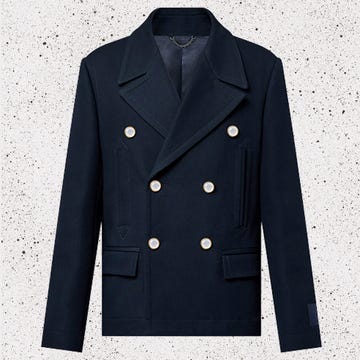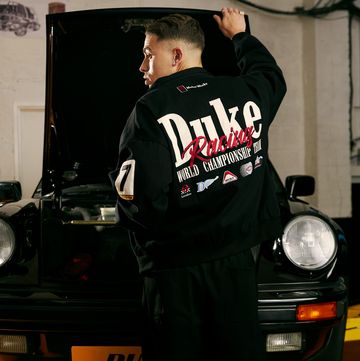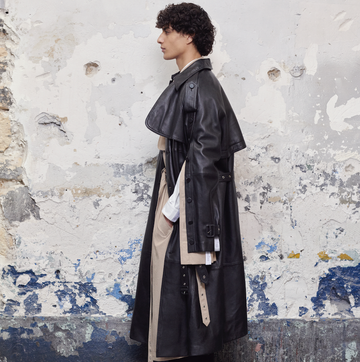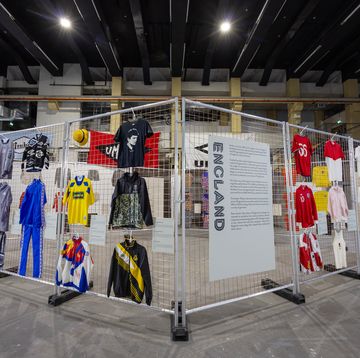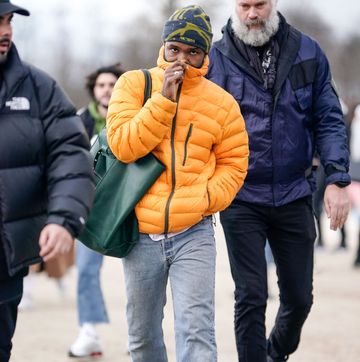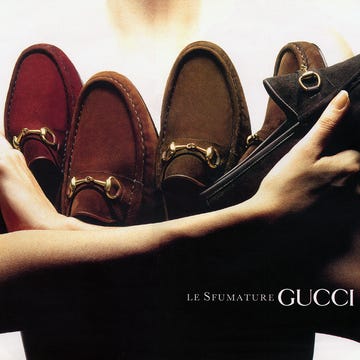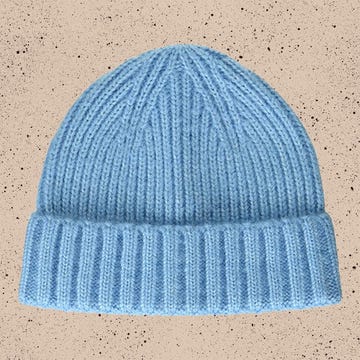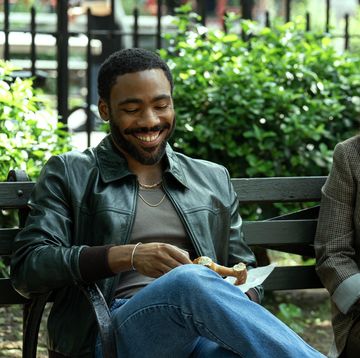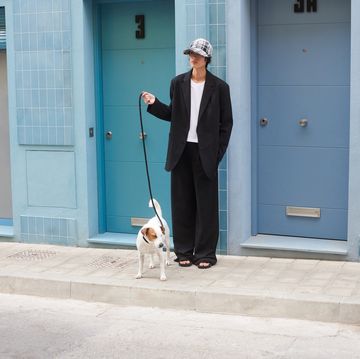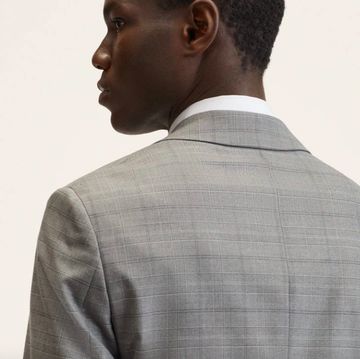It was American author and man of style Gay Talese who said, "putting on a beautifully designed suit elevates my spirit, extols my sense of self and helps to define me as a man to whom details matter."
SEE ALSO: The Complete Guide To Buying A Watch
With the erstwhile Esquire journalist's words in mind, here's our foolproof guide to buying (and looking good in) a suit. Because, as a far less prolific writer than Talese once said, "a well-tailored suit is to women, what lingerie is to men."
Here is everything you need to know about how to buy a suit.
Step One: The 5 Suits You Should (Eventually) Own
Navy Blue Single-Breasted
A navy blue single-breasted suit is the most versatile thing in your wardrobe, so it's probably worth investing in a few of them. One in a breathable cotton for summer, one in wool for winter and another in a mohair or silk mix for transitional seasons. Whether you wear yours with a T-shirt, a crew-neck sweater, a full placket polo shirt or a classic white shirt and tie combination, a solid blue suit will see you through. Opt for something with plenty of structure if you're long and lean, and something a bit lighter if you're on the shorter side.
Grey Windowpane Check Three-Piece
Three-piece suits aren't for everyone, but a high quality grey windowpane check suit, cut from a light, crisp-handled wool will quickly become one of the most useful tools in your tailoring arsenal. A great option for weddings or more formal occasions (when a morning suit isn't appropriate), the best thing about a three-piece suit is the fact that you can use each piece as a modular element in your look. The jacket can be worn as a blazer with some blue suit trousers, for instance; or you could wear the waistcoat with another of your suits for a more formal than usual effect. Those carrying a little extra timber around the midriff should probably avoid a three-piece.
Black Tuxedo
Though it's tempting to just hire a tuxedo every time an invitation with a black tie dress code lands in your inbox, we'd advise that you buy one. For the love of God, just buy one. A beautifully cut tuxedo with a smart peak lapel and satin or grosgrain details on the trousers and jacket will always look great - but you can rest assured it will look even better if it's not been worn by 500 men before you.
Pale Single-Breasted
A linen or cotton chino single-breasted suit in a pale shade of buff, stone or taupe is a summer essential. An easy yet smart way to tackle warm weather workdays and weddings, invest in something slim-cut, soft-handled, and half-lined (in order to avoid unsightly sweat patches) and wear with a granddad collar shirt or linen shirt and knitted tie combination. Go for a slightly darker shade if you're an apple or square shape, paler if you're slim.
Charcoal Double-Breasted
Nothing says, "I'm in charge and it's staying that way" like a perfectly cut, double-breasted charcoal flannel suit. Great worn with a shirt and tie (not to mention a pair of round tortoiseshell frames and a perfectly coiffed sweep of salt and pepper hair) the charcoal hue will make a welcome change from classic blue, and look different enough without feeling drastic. Double-breasted styles work best on those with broad shoulders and slim waists, as the extra fabric in the middle will help balance out the shoulder region a bit.
Step Two: Understanding The Details
The Lapels
The lapel of your suit jacket is the folded flap of fabric immediately beneath the collar. There are three main types of lapel.
The first is a notch. A triangle of fabric taken out of the lapel to create a step effect, this type of lapel works best on single-breasted jackets and is suitable for more casual or workaday situations.
The second type of lapel is a peak. Most commonly found on tuxedos and double-breasted jackets, a peak lapel points upwards towards the collarbone and is generally more evening-friendly.
The third is a shawl lapel. Most commonly found on tuxedos and smoking jackets, the shawl collar has an unbroken curve round from the collar to the naval and will add a Wildian loucheness to your look.
When it comes to the width of your lapel, in general you should opt for something between 8.5 to 10cm. Lapels at the wider end of the scale work better with double-breasted suits, as they will overpower single-breasted styles. As a rule, if you're wearing a tie, it should be around the same width as your lapel.
The Trousers
Suit trousers should sit on, or above your hip. A pleat will create a bit of room in the seat, while a turn up is great in the summer months if you plan on wearing a loafer. In general your trouser should mirror the shape of your leg and not cling or pull anywhere. You should be able to move and sit without stretching the fabric, so, when you try them on, ensure that you move around a bit before you buy them (any minor alterations can be made by a tailor).
Your trousers should gently taper at the bottom, just as your calves taper into your ankles and, unless you're intent on making a statement, they should kiss the top of your shoes. For a more classic fit, a single, clean break above the shoe is fine, but this is a matter of personal taste.
Finally, never wear a belt with your suit trousers. Ever.
The Body
The length of your jacket is of paramount importance. Your jacket should nip in at the waist (just above your hips) to give you some shape, and length-wise, should cover your seat.
There is a little room for maneuver with this, though how far you can push it depends on your body shape. Taller, slimmer frames can afford to go (slightly) shorter with the jacket, while shorter, squatter frames most certainly can't.
In addition, always check whether the structure of your suit is fused or canvased. If it's fused, it means the guts of the suit are held together with glue as opposed to natural canvas, and the surface of the suit will bubble over time. Not a good look.
The Shoulder
There are three main types of suit shoulder.
The first is the natural (or unstructured) shoulder. Made using a very thin pad (or no padding in some cases), this kind of shoulder works best on more casual, summery styles. A half or unlined jacket with a natural shoulder looks great on more built frames
The second is a structured shoulder. Encompassing all suits finished with padding, classic business suits tend to have relatively lightly padded shoulders. Suits with heavily padded shoulders are great for men who need some extra structure around the chest and shoulder region.
The third and final shoulder is a roped shoulder. An Italian favourite, a roped shoulder will give the wearer a slightly puffed, pompadour look. A hallmark of many bespoke tailors in Naples, a roped shoulder isn't for everyone, but is elegant nonetheless.
Step Three: The Tips
Find a Tailor You Trust
If you're buying your suit off the peg, it's imperative that you take it straight to an alterations tailor you trust and can build up a relationship with over time. It's a bit of a trial and error process, finding a good tailor, so don't jump straight in with your best suit, give him or her a pair of basic trousers to try first time round and grow your relationship from there. A good tailor will make even the cheapest suit look good.
Learn Your Body Shape
It's important to figure out what best suits your shape and colouring - there's only so much a tailor can do, after all. If you're short and portly, you should avoid double-breasted and three piece suits, as these will make you look shorter and wider. Likewise, if you're looking to hide a little extra weight, dark shades and thicker, drapey fabrics will be more effective at concealing lumps and bumps than a light linen.
If You Can, Buy Made-To-Measure
Unlike bespoke services, which tend to be prohibitively expensive and allow a customer to decide on every single element of his suit - from the fabric to the height of the armhole - made-to-measure services offer a series of template suit choices, which can be perfectly cut to fit your frame. Most brands now offer surprisingly affordable MTM services, with among best entry level services available from Polo Ralph Lauren, Hugo Boss and Tommy Hilfiger.
For those with a little more to spend Australian brand P Johnson (which is currently based in Soho) also does a fantastic line in close-cut, summer-ready custom made suiting, as does Savile Row stalwart Gieves & Hawkes.
Focus on Fabric
It doesn't matter how well your suit fits, if you opt for something cut from a shiny, cheap fabric, it will look shiny and cheap. Avoid synthetic cloths at all costs, as these add to the sheen and won't allow your suit to breathe. It's also important to choose season appropriate fabrics. Linen, cotton and mohair will cool you down in the summer; cashmere and tweed will keep you warm in the winter. Simple.



